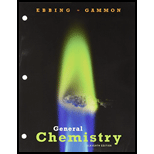
Concept explainers
(a)
Interpretation:
The functional group present in the given set of compounds has to be identified and circled.
Concept Introduction:
In an organic compound, the reactive portion is known as functional group. This undergoes reactions with other reagents and this does not depend upon how the rest of the compound is like. Few of the common functional groups are alcohol, ester,
To Identify and circle: The functional group present in the given compounds.
(b)
Interpretation:
The functional group present in the given set of compounds has to be identified and circled.
Concept Introduction:
In an organic compound, the reactive portion is known as functional group. This undergoes reactions with other reagents and this does not depend upon how the rest of the compound is like. Few of the common functional groups are alcohol, ester, carboxylic acid, ketone, aldehyde etc. Functional group determines the nature of the compound.
To Identify and circle: The functional group present in the given compounds.
(c)
Interpretation:
The functional group present in the given set of compounds has to be identified and circled.
Concept Introduction:
In an organic compound, the reactive portion is known as functional group. This undergoes reactions with other reagents and this does not depend upon how the rest of the compound is like. Few of the common functional groups are alcohol, ester, carboxylic acid, ketone, aldehyde etc. Functional group determines the nature of the compound.
To Identify and circle: The functional group present in the given compounds.
(d)
Interpretation:
The functional group present in the given set of compounds has to be identified and circled.
Concept Introduction:
In an organic compound, the reactive portion is known as functional group. This undergoes reactions with other reagents and this does not depend upon how the rest of the compound is like. Few of the common functional groups are alcohol, ester, carboxylic acid, ketone, aldehyde etc. Functional group determines the nature of the compound.
To Identify and circle: The functional group present in the given compounds.
Want to see the full answer?
Check out a sample textbook solution
Chapter 23 Solutions
Bundle: General Chemistry, Loose-leaf Version, 11th + OWLv2 with Student Solutions Manual eBook, 4 terms (24 months) Printed Access Card
- Indicate the number of einsteins that are equivalent to 550 kJ mol⁻¹ of absorbed energy?arrow_forwardA unit used in photochemistry is the einstein. If 400 kJ mol-1 of energy has been absorbed, how many einsteins is this equivalent to?arrow_forwardFor the condensation reaction between Alanine and histidine write the amididation reaction mechanism using arrows then write the three letter code for the product of the reaction and the one letter code for the product of the reaction.arrow_forward
- Name the following molecules using iupacarrow_forwardWrite the amididation reaction mechanism of a-aminophenol and acetic acid to produce acetaminophenarrow_forwardFor the condensation reaction between Alamine and histamine, please help me write the amididation reaction mechanism. Then write the three letter code for the product of the reaction, then write the one letter code for the product of the reaction. arrow_forward
 World of Chemistry, 3rd editionChemistryISBN:9781133109655Author:Steven S. Zumdahl, Susan L. Zumdahl, Donald J. DeCostePublisher:Brooks / Cole / Cengage Learning
World of Chemistry, 3rd editionChemistryISBN:9781133109655Author:Steven S. Zumdahl, Susan L. Zumdahl, Donald J. DeCostePublisher:Brooks / Cole / Cengage Learning Chemistry for Today: General, Organic, and Bioche...ChemistryISBN:9781305960060Author:Spencer L. Seager, Michael R. Slabaugh, Maren S. HansenPublisher:Cengage Learning
Chemistry for Today: General, Organic, and Bioche...ChemistryISBN:9781305960060Author:Spencer L. Seager, Michael R. Slabaugh, Maren S. HansenPublisher:Cengage Learning
 Organic Chemistry: A Guided InquiryChemistryISBN:9780618974122Author:Andrei StraumanisPublisher:Cengage Learning
Organic Chemistry: A Guided InquiryChemistryISBN:9780618974122Author:Andrei StraumanisPublisher:Cengage Learning Chemistry: Principles and ReactionsChemistryISBN:9781305079373Author:William L. Masterton, Cecile N. HurleyPublisher:Cengage Learning
Chemistry: Principles and ReactionsChemistryISBN:9781305079373Author:William L. Masterton, Cecile N. HurleyPublisher:Cengage Learning





